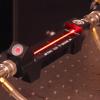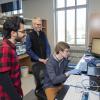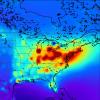Science & Technology
 CU Boulder will play a major role in a new center focused on developing infrastructure and systems that facilitate the widespread adoption of electric vehicles.
CU Boulder will play a major role in a new center focused on developing infrastructure and systems that facilitate the widespread adoption of electric vehicles. Imagine a textile that cleans itself, killing viruses and bacteria and dissolving flecks of embedded organic material. Such a fabric could transform the safety of seating in planes, buses and other public spaces—a particularly appealing prospect in current times.
Imagine a textile that cleans itself, killing viruses and bacteria and dissolving flecks of embedded organic material. Such a fabric could transform the safety of seating in planes, buses and other public spaces—a particularly appealing prospect in current times. Physicists at JILA achieve new feats of wafer-thinness in a study published this week.
Physicists at JILA achieve new feats of wafer-thinness in a study published this week. CU Boulder researchers have developed a new silicon chip with major applications in lidar systems for self-driving cars and smart phones.
CU Boulder researchers have developed a new silicon chip with major applications in lidar systems for self-driving cars and smart phones. Researchers have discovered an elusive phase of matter, first proposed more than 100 years ago and sought after ever since.
Researchers have discovered an elusive phase of matter, first proposed more than 100 years ago and sought after ever since. New CU Boulder research provides an unprecedented opportunity to study the history and evolution of human land-use and development in the United States.
New CU Boulder research provides an unprecedented opportunity to study the history and evolution of human land-use and development in the United States. Researchers at CU Boulder have developed an improved method for controlling smart tinting on windows that could make them cheaper, more effective and more durable than current options on the market.
Researchers at CU Boulder have developed an improved method for controlling smart tinting on windows that could make them cheaper, more effective and more durable than current options on the market. CU Boulder researchers and the CU spinoff VitriVax Inc. are focused on finding a way to get vaccines to 7.8 billion people.
CU Boulder researchers and the CU spinoff VitriVax Inc. are focused on finding a way to get vaccines to 7.8 billion people. Say hello to HAMR-Jr, the little robot—inspired by insects—that can do incredible things. Its diameter is just about the size of a penny and it weighs far less than a paperclip.
Say hello to HAMR-Jr, the little robot—inspired by insects—that can do incredible things. Its diameter is just about the size of a penny and it weighs far less than a paperclip. Researchers from NOAA and CU Boulder have devised a breakthrough method for determining emissions of carbon dioxide from fossil fuel combustion, which will also lead to more accurate estimates of carbon exchange between the land and atmosphere.
Researchers from NOAA and CU Boulder have devised a breakthrough method for determining emissions of carbon dioxide from fossil fuel combustion, which will also lead to more accurate estimates of carbon exchange between the land and atmosphere.


